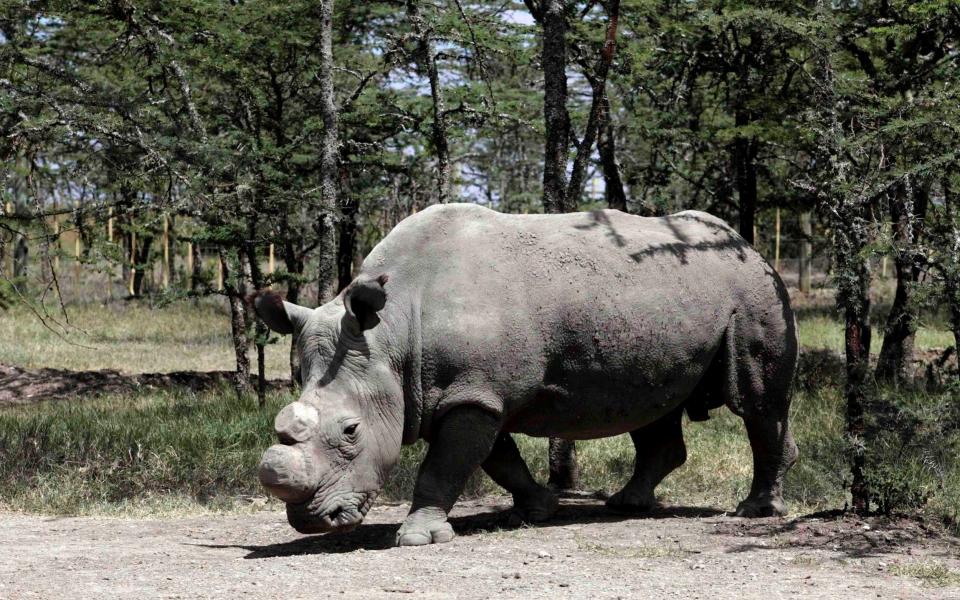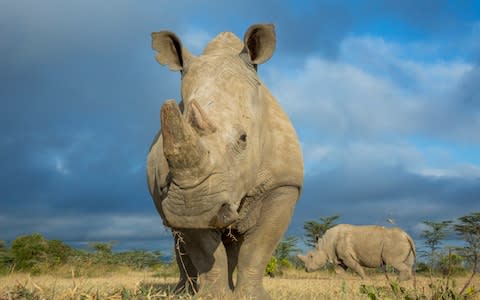Oxford fertility scientists launch last-ditch bid to save 'extinct' rhinoceros

Oxford University scientists have launched a last-ditch attempt to bring the Northern White Rhinoceros back from beyond the “point of no return” using IVF.
The team believes a pioneering treatment can prompt a revival of the persecuted species, despite the death last year of the last known male and the fact that the two remaining females, Najin and Fatu, cannot have calves.
One of two subspecies of White Rhinoceros, the Northern Rhinoceros once ranged over tracts of Uganda, Sudan, Central African Republic and the Democratic Republic of Congo.
However, the value of its horns saw it poached from a population of approximately 500 to 15 in the 1970s and 1980s.
A small recovery - numbers reached 32 - from the early 1990s was then reversed from 2003 when illegal hunting intensified again.
Mother and daughter, Nagin and Fatu now live in a heavily guarded semi-wild enclosure in Kenya, with their horns sawed off to deter poachers.
The Oxford researchers believe that it will be possible to remove ovarian tissue from the animals and stimulate it to produce eggs, which would then be fertilised from sperm preserved from male Northern White Rhinoceros.
The embryos would then be implanted into a surrogate mother of a similar species, probably a Southern White Rhinoceros.
The technique has been used successfully in mice for nearly two decades; it has also been accomplished for some species of dog, horse and cat.
However, it has never been attempted before on a rhinoceros, meaning the Oxford team plan to perfect it first by conducting a series of trials on ovarian tissue taken from a Southern White Rhinoceros.
Dr Suzannah Williams, who leads the Rhino Fertility Project, said: “Time is short.
“We have only got two left so we have to move fast.

She added: “With the death of the last male, Sudan, the Northern White Rhino has passed the point where it can be saved naturally and is a shade away from extinction.
“This will add yet another species to the list of those wiped out by humans.
“What is exciting about this research is that it could enable us to pull critically endangered species back from the brink by utilising ovarian tissue from old or injured animals to produce offspring.”
In principal, the benefit of removing ovarian tissue for use in the lab is that it can go on producing eggs.
Other researchers are exploring the possibility of using the remaining Northern White Rhinoceros sperm to cross-breed with Southern White Rhinoceros, however Dr Williams believes the focus should be on preserving the identity of the northern species.
“Once genetic variation within a population has been lost, it is lost forever,” she said.
“This makes it important for us to be able to maintain as many breeding individuals as possible in any conservation programme, to maximise genetic diversity of future populations.
“This will be a huge buffer against disease and ill health in the long-term, and give the new herds better genetic ability to adapt to changing environments in the future.”
Najin was born in captivity in 1989 and Fatu in 2000.
They both belong to the Cvur Kralove Zoo in the Czech Republic, which shipped them to the Ol Pejeta Conservancy in Kenya in 2009 amid tight security.
In place of their horns, keepers have fitted radio transmitters to allow close monitoring of their whereabouts in the large paddock areas.
The team has enough funding for three years’ research, donated from Fondation Hoffman, however Oxford University has launched a public appeal to raise the money to secure the project long term.

 Yahoo News
Yahoo News 